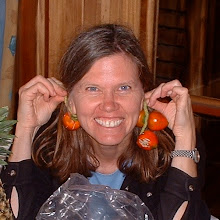We are very fortunate to have an excellent small family-owned grocery store near our house in Monteverde: the Mini Super Montaña. It's only a three minute walk from our house and I'm there almost everyday to pick up something or other. I used to do a lot of shopping downtown where the prices are slightly cheaper, until I realized that after I paid for a taxi to lug the stuff up the big hill home, it cost more and was less fun. At the Mini Super Montaña you are always greeted by a friendly face, such as Victor's.
(Not only are the staff friendly, the store acts as something of a social center for me because I often run into someone I know.) Over the years, Victor and his family members have put up with numerous lapses in my Spanish. Once, instead of asking for cilantro (culantro), I inquired if they sold snake (culebra).
The store has all the basic groceries and a miniature general store that sells everything from baby clothes to dishes and hardware. The selection of fruits and veggies is not large but they have all the basics, especially if you get there right after one of the frequent deliveries. This photo shows a time when the stock is getting a little low, but as you can see there were still excellent avocados, mangos and pineapples to be had.
Very few fruits or vegetables are refridgerated in Costa Rican stores. (The cilantro is kept in the cooler and that's why I didn't see it.)
People often ask me if I cook Costa Rican food at home. I like the homemade tortillas that a neighbor makes but I tend to cook mostly Italian recipes. I can find many supplies I need for that such as pasta, canned tomatoes, and olive oil.
I have to say that the most impressive section of our mini super is the laundry soap shelves. Ticos seem to have a lot of enthusiasm for cleaning products in general as reflected by their spotless homes.
By far the best feature of the store is the high level of service. I once had one of the staff cheerfully looking for sewing needles for about 5 minutes. When it turned out you could buy them one at a time, I was a big spender and sprang for two of them. (Incidentally, there are quite a few things you can buy just one of—from a stick of butter to a single band aid or aspirin.) Other services they do are numerous. Victor has been known to come in my taxi to carry a tank of gas into our house. They've let me have mail sent to me there because the mailman doesn't know where we are. I've taken knitting projects over and weighed balls of yarn and parts of sweaters on their scales. I like to feel I'm making their lives just a little more interesting by my odd requests. I know that they are enriching mine in more ways than I can count.
(Not only are the staff friendly, the store acts as something of a social center for me because I often run into someone I know.) Over the years, Victor and his family members have put up with numerous lapses in my Spanish. Once, instead of asking for cilantro (culantro), I inquired if they sold snake (culebra).
The store has all the basic groceries and a miniature general store that sells everything from baby clothes to dishes and hardware. The selection of fruits and veggies is not large but they have all the basics, especially if you get there right after one of the frequent deliveries. This photo shows a time when the stock is getting a little low, but as you can see there were still excellent avocados, mangos and pineapples to be had.
Very few fruits or vegetables are refridgerated in Costa Rican stores. (The cilantro is kept in the cooler and that's why I didn't see it.)
People often ask me if I cook Costa Rican food at home. I like the homemade tortillas that a neighbor makes but I tend to cook mostly Italian recipes. I can find many supplies I need for that such as pasta, canned tomatoes, and olive oil.
I have to say that the most impressive section of our mini super is the laundry soap shelves. Ticos seem to have a lot of enthusiasm for cleaning products in general as reflected by their spotless homes.
By far the best feature of the store is the high level of service. I once had one of the staff cheerfully looking for sewing needles for about 5 minutes. When it turned out you could buy them one at a time, I was a big spender and sprang for two of them. (Incidentally, there are quite a few things you can buy just one of—from a stick of butter to a single band aid or aspirin.) Other services they do are numerous. Victor has been known to come in my taxi to carry a tank of gas into our house. They've let me have mail sent to me there because the mailman doesn't know where we are. I've taken knitting projects over and weighed balls of yarn and parts of sweaters on their scales. I like to feel I'm making their lives just a little more interesting by my odd requests. I know that they are enriching mine in more ways than I can count.






























